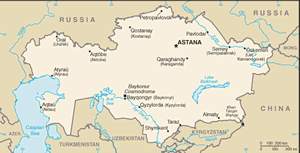The Geography of Kazakhstan
The Geography of Kazakhstan
Kazakhstani Geography
Location: Central Asia, northwest of China; a small portion west of the Ural River in eastern-most Europe
Geographic coordinates: 48 00 N, 68 00 E
Map references: Asia
Area: total: 2,717,300 sq km land: 2,669,800 sq km water: 47,500 sq km
Area - comparative: slightly less than four times the size of Texas
Land boundaries: total: 12,185 km border countries: China 1,533 km, Kyrgyzstan 1,224 km, Russia 6,846 km, Turkmenistan 379 km, Uzbekistan 2,203 km
Coastline: 0 km (landlocked); note - Kazakhstan borders the Aral Sea, now split into two bodies of water (1,070 km), and the Caspian Sea (1,894 km)
Maritime claims: none (landlocked)
Climate: continental, cold winters and hot summers, arid and semiarid
Terrain: extends from the Volga to the Altai Mountains and from the plains in western Siberia to oases and desert in Central Asia
Elevation extremes: lowest point: Vpadina Kaundy -132 m highest point: Khan Tangiri Shyngy (Pik Khan-Tengri) 6,995 m
Natural resources: major deposits of petroleum, natural gas, coal, iron ore, manganese, chrome ore, nickel, cobalt, copper, molybdenum, lead, zinc, bauxite, gold, uranium
Land use: arable land: 8.28% permanent crops: 0.05% other: 91.67% (2005)
Irrigated land: 35,560 sq km (2003)
Natural hazards: earthquakes in the south; mudslides around Almaty
Environment - current issues: radioactive or toxic chemical sites associated with former defense industries and test ranges scattered throughout the country pose health risks for humans and animals; industrial pollution is severe in some cities; because the two main rivers that flowed into the Aral Sea have been diverted for irrigation, it is drying up and leaving behind a harmful layer of chemical pesticides and natural salts; these substances are then picked up by the wind and blown into noxious dust storms; pollution in the Caspian Sea; soil pollution from overuse of agricultural chemicals and salination from poor infrastructure and wasteful irrigation practices
Environment - international agreements: party to: Air Pollution, Biodiversity, Climate Change, Desertification, Endangered Species, Environmental Modification, Hazardous Wastes, Ozone Layer Protection, Ship Pollution, Wetlands signed, but not ratified: Climate Change-Kyoto Protocol
Geography - note: landlocked; Russia leases approximately 6,000 sq km of territory enclosing the Baykonur Cosmodrome; in January 2004, Kazakhstan and Russia extended the lease to 2050


